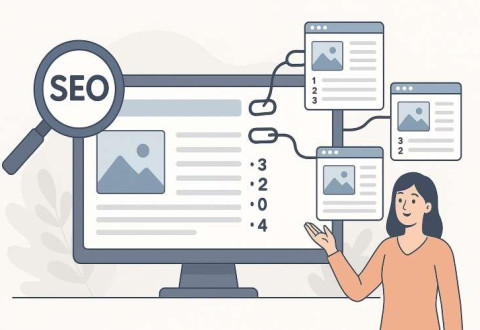Internal links are a powerful ranking factor that can significantly impact your website’s SEO performance. Not quite as powerful as high-quality backlinks, but very much worth your effort. While external links pointing to your site help establish domain authority, internal links distribute that authority throughout your web pages, telling Google which pages are more important.
Generally, when determining how many internal links per page SEO best practices recommend, aim for 5-10 internal links per 2,000 words, or about one link every 200-300 words. However, effective internal linking strategy goes beyond just quantity. When implemented correctly, internal links contribute to passing link juice, signaling important pages to search engine crawlers, improving user experience, increasing conversion rates, and enabling more efficient website crawling.
- What are Internal Links?
- How Many Internal Links Per Page for SEO?
- Why are Internal Links Important for SEO?
- The Science Behind Internal Link Quantity
- Types of Internal Links and Their Strategic Use
- Advanced Internal Linking Patterns
- Internal Linking Best Practices
- Measuring Internal Linking Success
- Conclusion
- FAQs
The magic isn’t in cramming as many links as possible into your content. Instead, it’s about creating a strategic network that guides both users and search engines through your most valuable content. Think of internal links as the nervous system of your website – they connect everything together and help information flow efficiently.
As we move into 2025, Google’s “Helpful Content” update has shifted focus toward expertise and user satisfaction rather than manipulative optimization. This means your internal linking strategy should prioritize genuine value over gaming the system.
What are Internal Links?

Internal links are hyperlinks that point to other pages within the same website, connecting different sections of your web pages. Unlike external links that lead to different websites, internal links keep users within your site’s ecosystem.
These links serve dual purposes: they help users navigate your content logically while providing search engine crawlers with crucial information about your site’s structure and page hierarchy. Internal links play a crucial role in distributing link equity throughout your site, similar to how backlinks pass authority between different websites.
Here’s a simple example of proper internal link implementation:
<a href=”/seo-guide”>Learn more about our comprehensive SEO guide</a>
The optimal format uses descriptive anchor text relevant to the target page. This approach helps both users understand what they’ll find and provides search engines with valuable context about the linked content on other pages.
Internal links work through the concept of link equity and PageRank algorithm. Around two decades ago, Google developed a special PageRank algorithm to calculate how authoritative web pages are. The more incoming internal links a given page has from high authority pages within the same website, the more important it appears to search engines.
How Many Internal Links Per Page for SEO?

A good internal linking structure ensures that each page receives appropriate internal links pointing to it from relevant content. For a blog post, you should have up to five internal links for 1,000 words and from five to ten internal links for a 2,000 words blog post.
The ideal number depends on content length and relevance. Avoid overloading relevant links, as Google devalues excessive linking similar to keyword stuffing. Focus on using descriptive anchor text that clearly describes the linked page content.
Remember, quality trumps quantity every time. It’s better to have fewer, highly relevant links connecting key pages than many random ones that don’t add value to your readers’ experience.
Why are Internal Links Important for SEO?
Internal links serve as the foundation of effective website navigation and information hierarchy. They help establish which content deserves the most attention while distributing link equity throughout your site. However, broken internal links can negatively impact both user experience and SEO through 404 errors that diminish site authority.
1. Internal Links Build Your Pages’ Authority
The most valuable property of internal links is that they can pass link juice — they can tell Google which pages of your website are more important. This creates a hierarchy within your site’s internal linking strategy that search engines can understand and follow.
Imagine you run a bicycle shop website. Your comprehensive “Bike Maintenance Guide” receives multiple internal links pointing from product pages, blog posts, and category pages. This signals to Google that the guide is valuable content worth ranking higher in search engine rankings. You can then leverage this authority by adding internal links from the guide to newer, less established pages, helping boost their rankings within your site’s hierarchy.
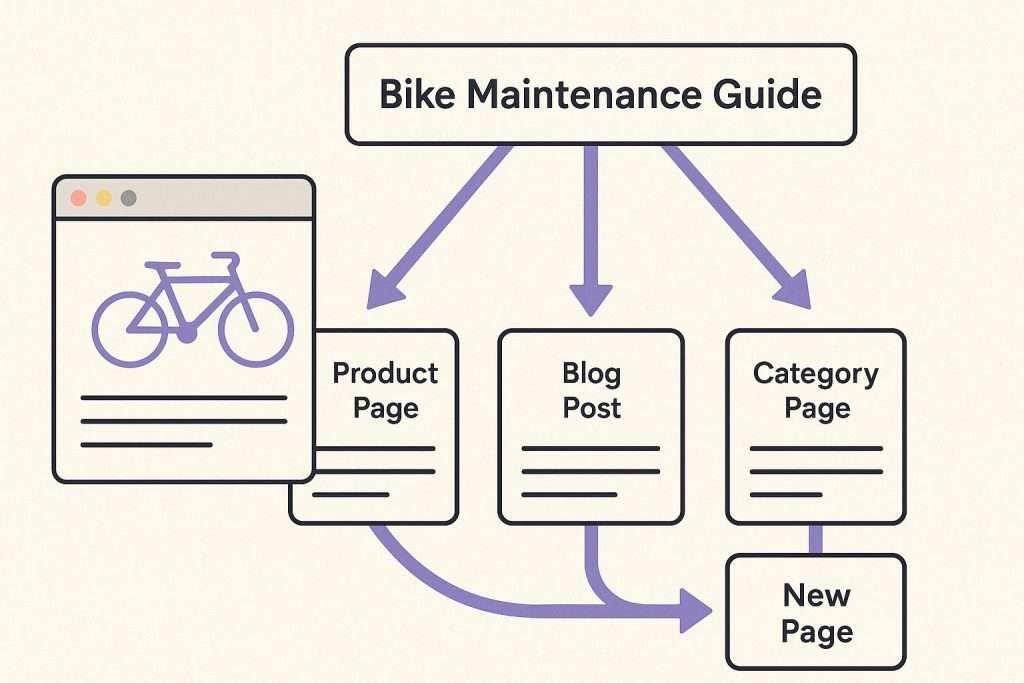
By creating a solid internal linking strategy, you can identify which pages have high authority and strategically link from them to key pages that need ranking boosts.
2. Internal Linking Makes People Stay Longer on Your Site
Strategic internal linking improves website navigation and maintains an easy-to-follow website structure. While this is primarily a user experience benefit, a logical website structure also saves up on your crawl budget, allowing search engines to index more pages per visit.
When users can easily find related content through contextual internal links, they spend more time exploring different web pages on your site. This increased dwell time sends positive signals to search engines about your content quality and relevance.
3. Internal Links Work to Create a Good Site Architecture
To tackle internal link building, you’ll need some quality SEO tools and services to save time and get better results. Essential tools include Google Analytics for tracking user behavior, Website Auditor for analyzing link structure, and Rank Tracker for monitoring keyword performance.
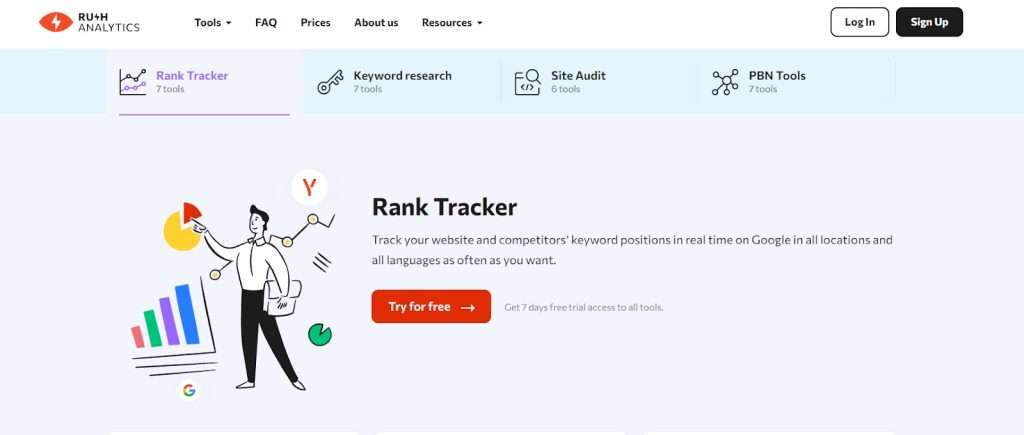
A well-structured site helps both users and search engine crawlers navigate content efficiently. Internal links act as pathways that guide crawlers through your most important pages, ensuring comprehensive indexing and proper authority distribution across one page to another.
The Science Behind Internal Link Quantity
Understanding the research behind internal link optimization helps you make data-driven decisions about your linking strategy.
Research-Backed Data on Optimal Internal Link Density
A Zyppy SEO study analyzing over 23 million internal links revealed that pages with 45-50 internal links experienced significant organic traffic increases, while exceeding this number reversed the benefit. This occurs because Google assigns value to links, and excessive linking dilutes the authority passed to each individual link.
The study found that URLs with 50+ links began experiencing traffic declines, suggesting there’s a sweet spot for internal link density. This data reinforces the importance of strategic rather than excessive linking.
Impact on Crawl Budget and User Experience
Excessive internal links can waste Google’s limited crawl resources on low-priority pages. The famous eBay case study from 2025 demonstrates how link overload contributed to significant traffic loss during the Panda update.
From a user perspective, too many links can confuse search engines regarding the site’s focus and content hierarchy. While well-structured internal linking helps users navigate efficiently, overwhelming visitors with numerous links makes content harder to read and diminishes the overall experience.
Why Does the Optimal Number Vary?
The ideal number of internal links varies based on several factors:
Content Length: A 500-word page with 40 links feels overcrowded, while a 5,000-word comprehensive guide can naturally accommodate the same number without appearing spammy.
Site Structure: E-commerce sites typically feature many links between product and category pages, while blogs often have more linear structures focusing on topic relationships.
Link Deeper Pages to Authority Pages: Link deeper pages to more authoritative pages like the home and category pages. Strategic linking to pillar content or key pages delivers more SEO benefit than random linking to low-value pages.
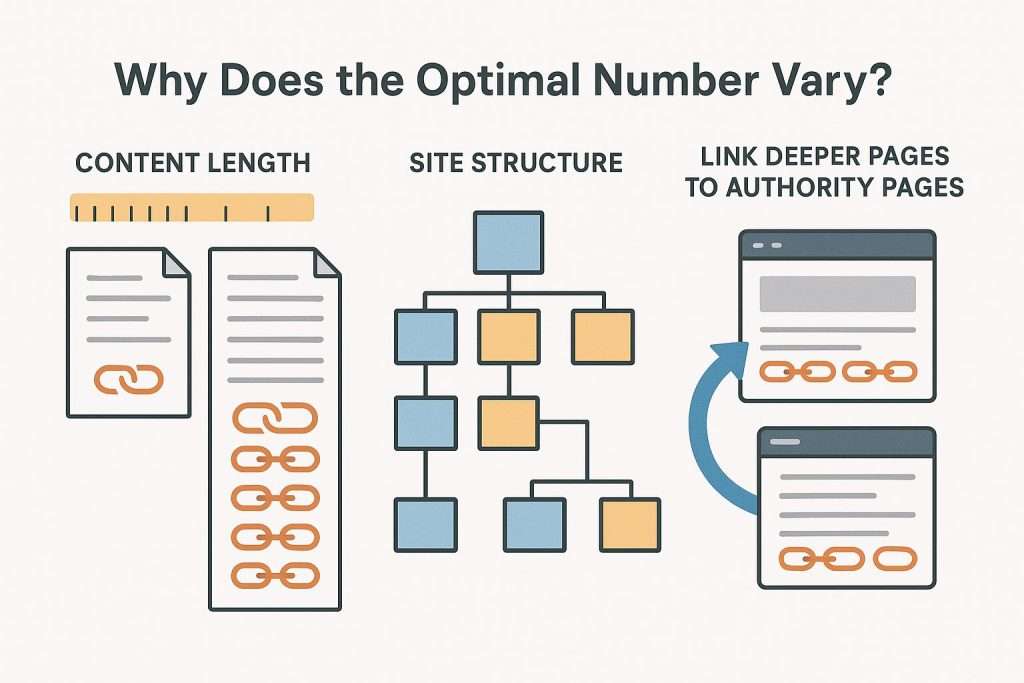
So, How Many Internal Links Are Too Many?
Google’s John Mueller states that excessive internal links reduce their effectiveness. Moz says search engines have a crawl limit of 150 links per page before crawlers stop crawling, though important pages may have 200-250 dofollow links.
The more links, internal or external, are found on a page, the less link juice each link sends to the page it points to. Too many links can also dilute PageRank and cause Google to potentially ignore some links entirely.
Remember that header, footer, and menu links count toward your total link count. Keep total links within 100-150 per page for optimal performance when building your solid internal linking strategy.
Types of Internal Links and Their Strategic Use

Different types of internal links serve various purposes in your overall SEO strategy. Understanding these categories helps you implement a more targeted approach.
The most important distinction is between navigational links and contextual links. Navigational links help users navigate through website pages and define site structure, while contextual links point to related articles within content, increasing user engagement and reducing bounce rates.
Contextual Links
Contextual links appear within your article text and serve dual purposes: guiding readers to related content while strengthening SEO by establishing connections between pages. For example, within a digital marketing article, linking to “marketing tools” provides additional value while boosting the linked page’s authority.
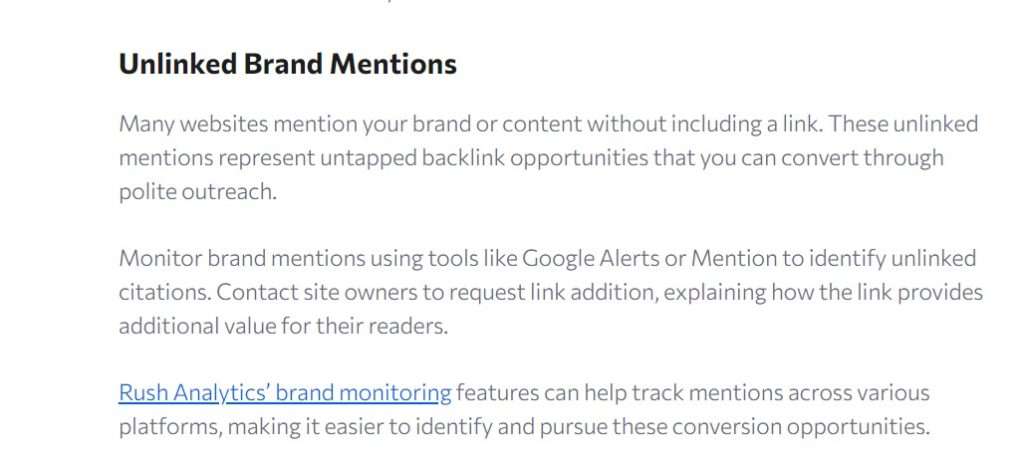
Links placed within a page’s main content have higher SEO value than those in the header, footer, or sidebar. The surrounding text and keywords matter for the ranking of the target page, making contextual placement crucial for maximum impact.
Navigation Links
Navigation links appear in your site’s main menu, helping visitors quickly orient themselves by linking to key sections like the homepage or About Us page. These links improve user experience while signaling to Google which pages you consider most important.

Well-organized navigation creates a clear hierarchy that benefits both users and search engines in understanding your site’s structure and priorities.
Footer Links
Footer links direct users to less visible but important content such as FAQs, contact information, legal notices, or privacy policies. These links can improve the SEO of less frequently visited pages by providing additional pathways for both users and crawlers.
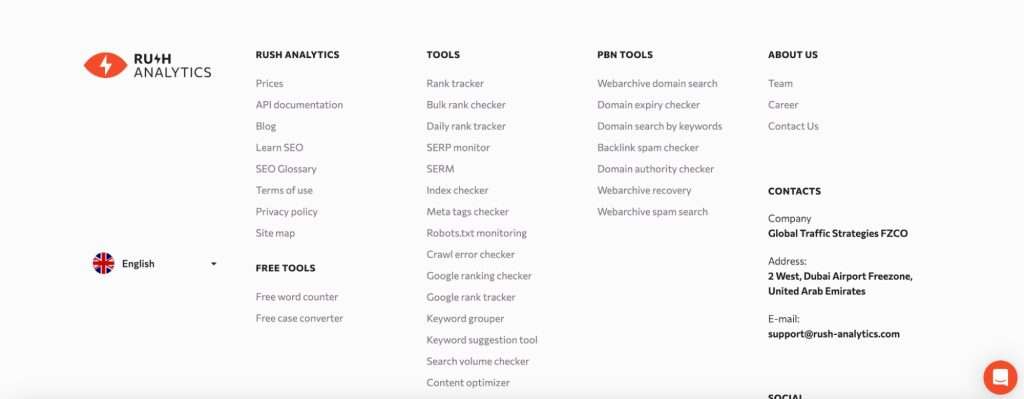
Airbnb’s footer exemplifies clear navigation with essential links presented in a clean, organized design that doesn’t overwhelm users while maintaining accessibility to important pages.
Sidebar Links
Sidebar links typically appear on blog pages, linking to similar articles or popular categories. They guide users to other interesting content, increasing engagement and facilitating easy navigation across different pages of your site.

These links work particularly well for content discovery, helping users find related topics they might not have searched for directly.
Nofollow Internal Links
The nofollow attribute was originally used to manipulate PageRank flow, but later algorithm changes made this ineffective. While dofollow links pass link equity to the linked page, nofollow links waste it, making nofollow tags rather senseless in internal linking for SEO.
Modern SEO best practices recommend auditing your site for excessive internal nofollows and removing them to allow PageRank to flow freely across your pages. Focus on site structure and fresh content instead of trying to manipulate link equity internally.
Bookmarks
Bookmarks (named anchors) are internal links referring to specific sections within the same page. They’re implemented using HTML <a href=”#anchor-name”> syntax and prove useful for lengthy pages, allowing quick navigation between different sections like table of contents and referenced materials.
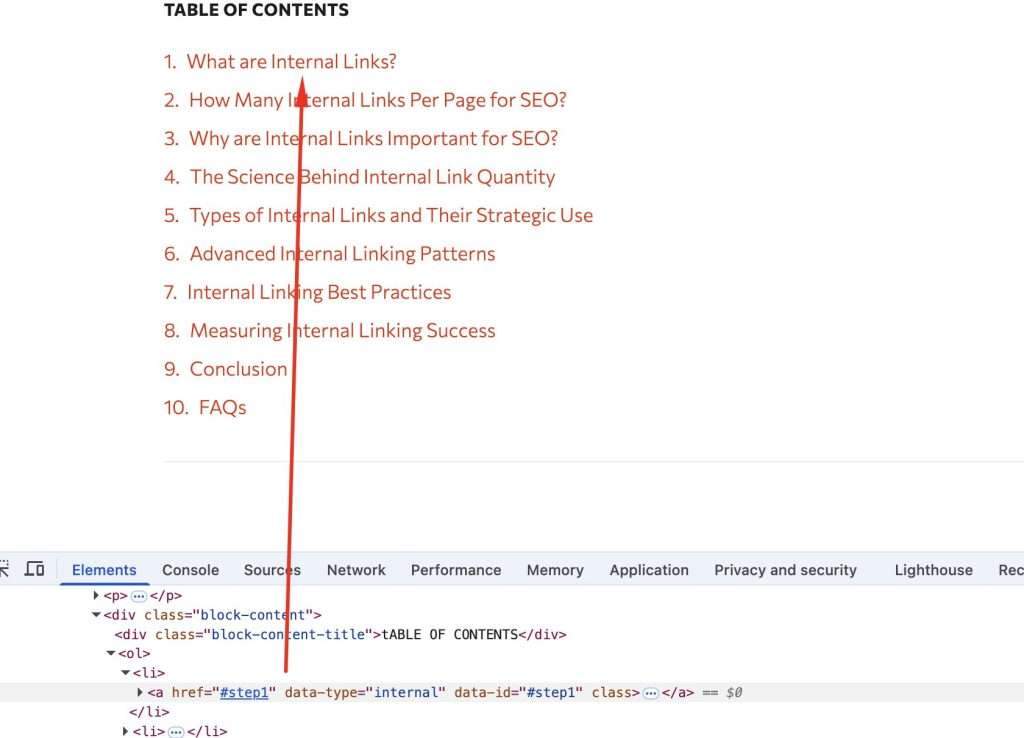
Next/Prev Links
While Google abandoned the rel=next/prev attribute, SEOs still implement pagination for users and other search engines. Google recommends that each page in a series should be relatively self-sufficient, providing value even when viewed independently.
Help Links
Help links create excellent opportunities for contextual linking to resources with useful information related to the source page’s topic. These links naturally integrate into content while providing additional value to users seeking more detailed information.
Author Links
Adding author attributes to links indicates a page represents an author’s profile, which enhances content credibility and helps establish expertise, authority, and trustworthiness (E-A-T) signals that Google values.
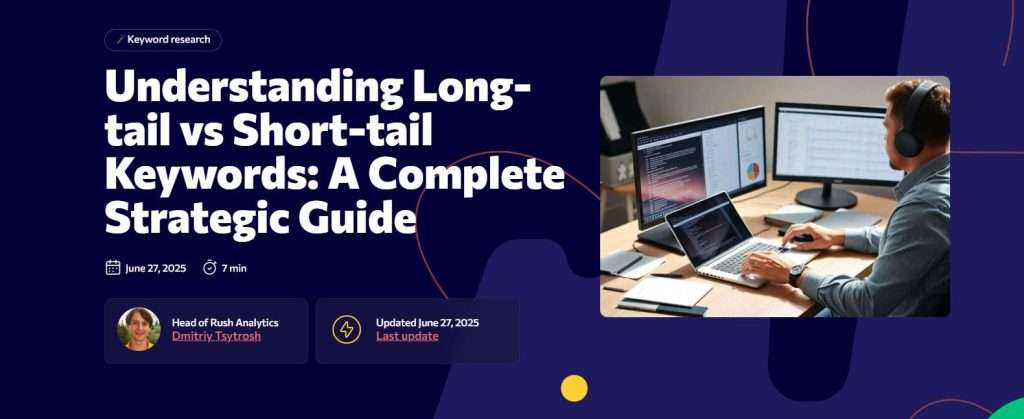
Understanding Internal Link Authority Flow
Internal links distribute link equity and PageRank from the current page to the linked pages. This concept of “link juice” represents the SEO value passed through hyperlinks, helping improve visibility in search results.
Consider a culinary blog receiving a dofollow link from Marmiton, an established cooking website. This external authority can then be distributed throughout the blog via strategic internal linking, strengthening multiple pages rather than benefiting just the initial landing page.
PageRank and Authority Distribution
PageRank is Google’s algorithm for evaluating page importance based on incoming link quantity and quality. Wikipedia exemplifies high PageRank distribution – as a high-authority site, it passes powerful link juice through both internal and external links.
Pages receiving links from high-authority sources gain significant SEO benefits that can be distributed through strategic internal linking structures. This creates a multiplier effect where external authority benefits multiple pages instead of remaining isolated.
Link Juice Optimization Strategies
Link position significantly affects authority flow. Links placed “above the fold” (visible without scrolling) receive priority from search engines compared to footer links.
For example, an e-commerce homepage featuring an internal link to a “new arrivals” page near the top of the page passes more authority than the same link buried in the footer. Strategic placement maximizes the SEO impact of your internal linking efforts.
Analyze your internal link placement and optimize for maximum authority transfer by focusing on contextual links within your main content areas.
Optimizing Link Depth
Pages should be no more than three clicks away from the homepage, as a My Rankings Metrics study found that pages at depths 1-3 generate nine times more SEO traffic than deeper pages.
Maintaining a shallow site structure benefits both user experience and crawl efficiency. Users shouldn’t need to navigate through multiple levels to find important content, and search engines can more easily discover and index pages that are closer to your homepage.
Advanced Internal Linking Patterns
Moving beyond basic strategies, advanced internal linking patterns help create more sophisticated content relationships and authority distribution.
Topic Clusters and Pillar Pages
Topic clusters organize content around broad themes, with pillar pages serving as comprehensive foundations that link to specific subpages for deeper exploration. This approach helps search engines understand your site’s expertise while improving user experience through logical content organization.
By grouping content into topic clusters and linking related pages to a central hub or pillar page, you can establish stronger topical authority. This method also helps Google better understand your site’s layout and content relevance.
Hub and Spoke Model
The Hub and Spoke model creates content networks where the main page (hub) links to specific pages (spokes), spokes link back to the hub, and related spokes connect to each other. This interconnected structure helps visitors find content easily while signaling content relationships to Google.
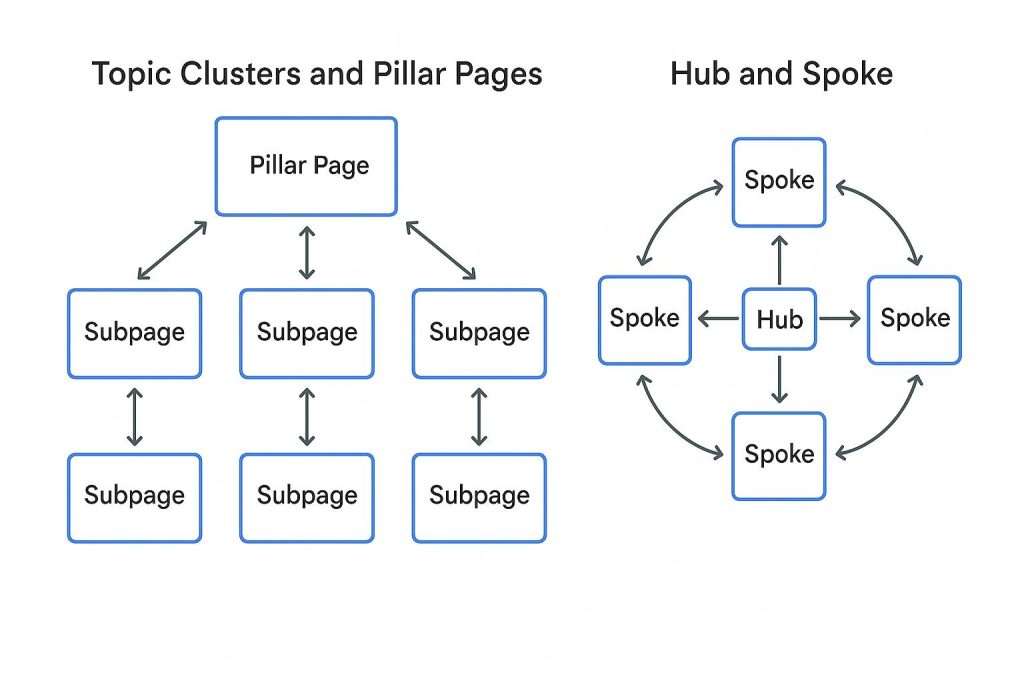
This network helps distribute authority across pages for better overall SEO performance. The model works particularly well for businesses with multiple service areas or comprehensive resource libraries.
Blog Architecture Strategies
Well-structured blogs resemble trees with clear branches, where each blog post links logically to relevant pillar and category pages. This organization helps both search engines and users find related content while distributing link value throughout the site.
Strategic blog architecture with relevant internal links helps search engines index content more efficiently while creating natural user journeys through your content ecosystem.
Internal Linking and Silo Structure
Silos organize content by theme with broad topic pages (pillars) linking to specific subpages, helping search engines understand site structure and potentially improving rankings. The approach recommends keeping internal links within the same silo for maximum relevance.
This contrasts with the more flexible cluster mapping method, though both strategies enhance site organization. The strict silo approach works well for highly specialized websites, while cluster mapping suits sites with overlapping topics.
Breadcrumb Navigation
Breadcrumbs show the path from homepage to current page (e.g., Home > Products > Shoes > Leather Sneakers). Breadcrumbs benefit both users by allowing easy navigation to previous categories and search engines by helping Google understand site structure for better indexing.
They’re particularly valuable for sites with multiple categories or deep page structures, providing both navigational assistance and SEO benefits through clear hierarchy signals.
Internal Linking Best Practices
Before implementing advanced strategies, ensure these fundamental best practices form the foundation of your internal linking structure.
1. Keep a Shallow Website Structure
Maintain a website structure where important pages can be reached within three clicks of the homepage. Modern users demand fast access to information and won’t navigate through numerous unnecessary links when competitors offer better-organized alternatives.
Use tools like Website Auditor to check your internal pages’ click depth and ensure important landing pages remain easily accessible. Pages buried too deep in your site architecture receive less authority and may be overlooked by both users and search engines
2. Make Sure All the Important Pages Are Linked
Orphan pages (pages not linked from anywhere on the same website) create missed opportunities for both users and search engines. Google discovers new pages by following links, so orphaned pages are hard to find and won’t be indexed or appear in search engine rankings.
Use Website Auditor to identify orphan pages and create strategic internal links to them. Consider implementing “siloing” or topic clusters with pillar pages linked to related content, which helps both users and search engines understand your site structure.
3. Do Internal Link Audit to Optimize Your Crawl Budget
Regular auditing prevents wasting crawl budget on broken pages or redirect chains. Use Google Search Console and Website Auditor to find broken internal links and redirects with 301 and 302 HTTP status codes.
Fixing these issues ensures search engines can efficiently crawl your site’s valuable content rather than encountering errors that waste their limited crawling resources.
Pro Tip: Set up automated monitoring to catch new broken links before they impact your SEO performance.
4. Keep the Number of Links Per Page Reasonable
The more links on a page, the less link juice each link sends to its destination. Excessive linking can also send spam signals to search engines, potentially harming your rankings.
Reducing outgoing links increases the “ranking power” sent to each linked page. Use Website Auditor to identify pages with excessive links (over 100 internal and external combined) and optimize them for better authority distribution.
5. Use Keywords in the Anchor Text
Strategic anchor text boosts topical relevance, with internal links acting similarly to backlinks in this regard. Google has confirmed that multiple internal links with the same anchor text won’t hurt you unless overdone.
However, vary your anchor text to avoid appearing manipulative. Mix exact-match keywords with related phrases and natural language to create a diverse, authentic linking profile.
Use site auditing tools to analyze your internal anchor text distribution and identify opportunities for improvement.
6. Make Sure Image Links Have Alt Attributes
Alt attributes for image links function like anchor text for text links, providing ranking signals to search engines. This creates additional opportunities to communicate page relevance and context.
Use a site audit dashboard to find image links with empty alt text and optimize them for better SEO performance. Proper alt text also improves accessibility for users with visual impairments.
7. Place Contextual Links Within the Main Content
Links placed within a page’s main content have higher SEO value than those in headers, footers, or sidebars. Content links add new information and value to your text, while Google treats navigation links as non-editorial.
The surrounding text and keywords matter for the ranking of target pages, making contextual placement within your primary content crucial for maximum SEO impact.
8. Open Contextual Links in a New Tab
Opening contextual links in new tabs prevents users from losing their browsing context. Think about how easily users get distracted following links – they might start reading about SEO techniques and end up watching puppy videos three clicks later!
Use the HTML target=”_blank” attribute to force browsers to open contextual links in new tabs:
<a href=”/related-article” target=”_blank”>Read our related guide</a>
This approach maintains user engagement with your original content while still providing access to additional resources.
Free 7 days access to all tools. No credit card required!
Попробовать бесплатно
Measuring Internal Linking Success
Tracking the effectiveness of your internal linking strategy requires monitoring specific metrics and using appropriate tools.
1. Key Metrics to Track
Monitor these five essential metrics to evaluate internal linking effectiveness:
- Internal links per page: Ensure you’re within optimal ranges without excessive linking
- Clicks and impressions from Google Search Console: Track how internal links influence search performance
- Click-through rate (CTR): Higher CTRs indicate effective link placement and anchor text
- Session time: Longer sessions suggest effective internal link guidance
- Bounce rate: High bounce rates may signal ineffective internal linking strategies
These metrics reveal how well your internal links guide users to relevant content and contribute to overall site performance.
2. Tools for Analyzing Internal Links
Leverage these eight tools for comprehensive internal link analysis:
Free Options:
- Google Search Console: Provides link performance data and indexing insights
- Google Analytics: Tracks user behavior and content interaction patterns
- Screaming Frog SEO Spider: Identifies broken links and structural issues
Paid Solutions:
- Ahrefs: Offers detailed link distribution insights and competitive analysis
- SEMrush: Provides comprehensive site auditing and optimization suggestions
- Rush Analytics Website Auditor: Specialized internal linking analysis and optimization
Specialized Tools:
- LinkWhisper: AI-powered link suggestions for WordPress sites
- Sitebulb: Visual link graphs and advanced crawl analysis
3. Regular Audit Procedures
Conduct regular internal link audits focusing on three key areas:
Fix Broken Links: Use tools like Screaming Frog and Ahrefs to identify and repair broken internal links that harm user experience and waste crawl budget.
Review Website Structure: Ensure important pages remain within three clicks of the homepage and optimize navigation paths for better accessibility.
Optimize Anchor Text: Review anchor text distribution to maintain relevance while avoiding over-optimization that might trigger spam filters.
These procedures improve both user experience and SEO rankings through systematic maintenance of your internal linking structure.
4. Performance Benchmarking
Compare current metrics to historical data to evaluate the impact of internal linking changes. Effective internal linking should yield measurable improvements in traffic, bounce rates, and engagement.
Set concrete goals such as reducing bounce rates by 10% or increasing page views per session by 15% through improved internal linking. Regular benchmarking helps identify successful strategies and areas needing improvement.
5. Measuring Return on Investment (ROI)
Track ROI through conversion monitoring and before/after performance comparisons. Conversion tracking reveals whether internal links successfully drive users toward important actions like purchases or newsletter signups.
Effective internal linking structures should demonstrate clear improvements in user engagement, lead generation, and revenue attribution. Use this data to justify continued investment in internal linking optimization and guide future strategy decisions.
Conclusion
Effective internal linking requires strategic planning rather than simply adding numerous links throughout your content. While there’s no magic number for internal links per page, the focus should remain on relevance, natural integration, and guiding users to valuable content.
Remember to distribute authority properly while avoiding common mistakes like excessive linking or poor anchor text optimization. As practices evolve in 2025, internal links remain a foundational on-page SEO factor that forms the backbone of user experience and SEO success.
FAQs
How many links should be on a page?
The optimal number varies by content length and purpose, but generally aim for 5-10 internal links per 2,000 words. Keep total links under 150 per page to maintain link equity effectiveness and avoid diluting PageRank distribution.Are too many internal links bad for SEO?
Yes, excessive internal links can dilute link juice, confuse search engines about page hierarchy, and send spam signals. Focus on quality over quantity, ensuring each link provides genuine value to users rather than attempting to manipulate rankings.How many internal links per 1000 words?
For 1,000-word content, include 3-5 strategic internal links. This ratio ensures adequate linking without overwhelming readers or diluting the authority passed to each linked page. Adjust based on content relevance and user intent.How many hyperlinks is too many?
Most SEO experts recommend staying under 100-150 total links per page, including both internal and external links. Google’s crawlers may stop following links beyond this threshold, reducing the effectiveness of your linking strategy.Do internal links count as backlinks?
No, internal links connect pages within the same domain, while backlinks come from external websites. However, internal links do pass link equity and authority between pages on your site, making them valuable for SEO though less powerful than external backlinks.Do internal links boost SEO?
Yes, internal links boost SEO by distributing PageRank, helping search engines understand site structure, improving crawlability, and enhancing user experience. They signal page importance and create pathways for authority flow throughout your website.What link carries the most value on a page?
Contextual links within the main content typically carry the most SEO value, especially when placed “above the fold.” These links provide editorial context and receive more weight from search engines compared to navigational or footer links.
References
- https://moz.com/learn/seo/internal-link
- https://www.link-assistant.com/news/internal-linking-strategies.html
- https://www.forbes.com/councils/forbesagencycouncil/2025/01/03/on-page-seo-how-many-links-is-too-many-on-a-webpage/
- https://neilpatel.com/blog/the-complete-guide-to-internal-linking/
- https://www.internallinkjuicer.com/hub/strategies/how-many-internal-links-per-page/
- https://inblog.ai/blog/how-many-internal-links-per-page-seo
- https://www.directom.com/internal-links-affect-seo/


